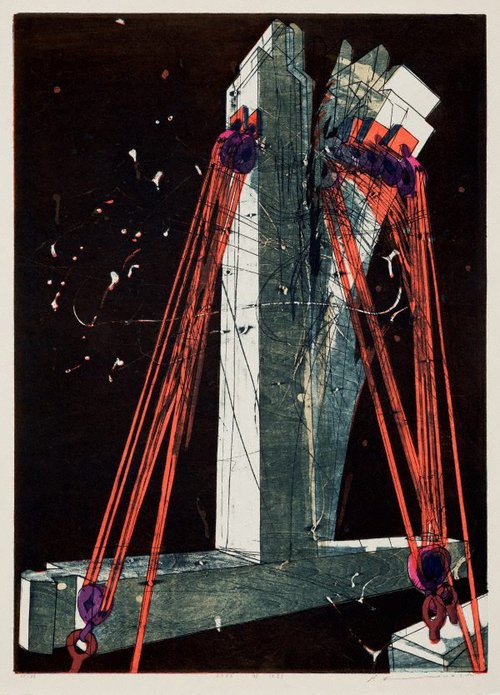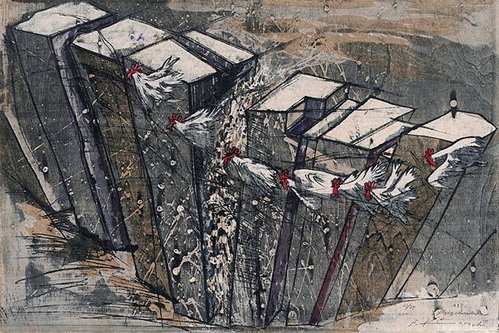-
Details
- Alternative title
- Kanojo (IV)
- Place where the work was made
-
Japan
- Period
- Heisei period 1989 - → Japan
- Date
- 1991
- Media category
- Materials used
- woodcut
- Edition
- 11/50
- Dimensions
- 60.5 x 43.3 cm image; 67.3 x 48.2 cm sheet
- Signature & date
Signed l.r., pencil "S.Kawachi". Dated l.c., pencil "1991".
- Credit
- Gift of the artist 1993
- Location
- Not on display
- Accession number
- 431.1993
- Copyright
- © KAWACHI Seikô
- Artist information
-
Kawachi Seikō
Works in the collection
- Share
-
-
About
Kawachi was the most prominent of the younger artists who led the revival of the woodblock in the 1970s. He has been winning prizes since a student at Tama Art University, and his work has been sought by collectors from around the world. Born in Yamanashi Prefecture and now living in Tokyo, Kawachi is perhaps better known for his large, disquieting images of wooden beams stretched to breaking point. Such taut images, frenetically executed and full of tension and a foreboding sense of crisis, were regarded as metaphors for the catastrophe of our modern over-stressed society.
This particular print is atypical of his oeuvre to date. In it his theme is love - for him, to decorate a hat with flowers for someone is an expression of love. The idea of depicting a loved one by association rather than physical presence has a long tradition in Japanese art. The most notable example is the genre of 'Tagasode' ('whose sleeves?') painting, in which the presence of a woman was evoked by the depiction only of her beautifully draped kimono - the subject itself is not depicted.
Although the subject is gentler and more personal than that of his earlier work, this print still contains the excitement, movement and frantic lines typical of Kawachi's style. While reviving the woodblock medium, Kawachi has added his own innovations. For example, he usually prints his colours first, and then his black lines, the reverse of traditional woodblock printing methods. In addition, for his black lines he employs a unique intaglio printing method that heightens their impact.
Jackie Menzies, Contemporary Japanese Prints: The Urban Bonsai, 1992, pg. 56.
-
Places
Where the work was made
Japan
-
Exhibition history
Shown in 1 exhibition
The Urban Bonsai, Queensland Art Gallery, South Brisbane, 04 Mar 1992–04 May 1992
The Urban Bonsai, National Art Gallery, Wellington, Wellington, 20 Jun 1992–09 Aug 1992
The Urban Bonsai, Christchurch Art Gallery, Christchurch, 12 Sep 1992–29 Oct 1992
The Urban Bonsai, Manawatu Art Gallery, New Zealand, 13 Nov 1992–10 Jan 1993
The Urban Bonsai, The George Adams Gallery, Victorian Arts Centre, Melbourne, 18 Mar 1993–25 Apr 1993
The Urban Bonsai, Art Gallery of New South Wales, Sydney, 08 May 1993–01 Aug 1993
The Urban Bonsai, Penrith Regional Gallery & The Lewers Bequest, Emu Plains, 11 Mar 1994–24 Apr 1994
The Urban Bonsai, Drill Hall Gallery, Australian National University, Canberra, 19 May 1994–19 Jun 1994
The Urban Bonsai, Campbelltown Arts Centre, Campbelltown, 15 Jul 1994–21 Aug 1994
The Urban Bonsai, Bank Art Museum Moree, Moree, 11 Nov 1994–24 Dec 1994
The Urban Bonsai, Tweed Regional Gallery & Margaret Olley Art Centre, Murwillumbah, 01 Feb 1995–05 Mar 1995
-
Bibliography
Referenced in 1 publication
-
Jackie Menzies, Contemporary Japanese Prints : The Urban Bonsai, Sydney, 1992, 50 (colour illus.), 56. cat.no. 26
-




